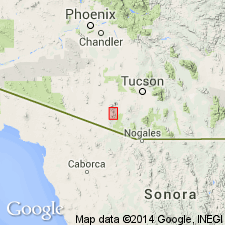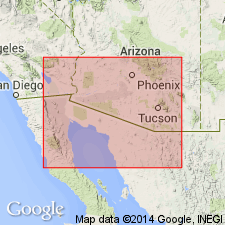
- Usage in publication:
-
- Ali Molina Metamorphic Complex*
- Modifications:
-
- Original reference
- Dominant lithology:
-
- Andesite
- Rhyolite
- Latite
- Quartzite
- Conglomerate
- Phyllite
- AAPG geologic province:
-
- Basin-and-Range province
Summary:
Pg. I5-I6. Ali Molina Metamorphic Complex. Consists mostly of massive blue-gray flinty silicified sedimentary and volcanic material and to lesser extent of dark-gray to greenish-black phyllite, gray quartzite, and locally, sericitic schist. Top of section faulted and base not seen but attitude of beds and known width of outcrop suggest total thickness of several thousand feet. Considered to be Mesozoic(?) because it contains volcanic rocks which do not occur in Paleozoic rocks in southern Arizona and because it is disconformably overlain by Tertiary rocks. Part of complex may be metamorphosed equivalent of Pitoikam Formation (new).
Named from exposures along Ali Molina Canyon, Baboquivari Mountains, Papago Indian Reservation, Pima Co., southwestern AZ.
Source: US geologic names lexicon (USGS Bull. 1350, p. 14).

- Usage in publication:
-
- Ali Molina Formation*
- Modifications:
-
- Redescribed
- Age modified
- AAPG geologic province:
-
- Basin-and-Range province
Summary:
Changed from Metamorphic Complex to Formation. Is of Early Jurassic age based on isotopic age of zircon and apparent relations with other rocks. Is probably correlative with Ox Frame Volcanics. Is in part equivalent to Pitoikam Formation.
Source: GNU records (USGS DDS-6; Denver GNULEX).

- Usage in publication:
-
- Ali Molina Formation*
- Modifications:
-
- Age modified
- AAPG geologic province:
-
- Basin-and-Range province
Summary:
U-Pb isotopic ages indicate an age of 185 to 195 m.y., or late Early to early Middle Jurassic [rather than Early Jurassic as previously accepted]. Middle Jurassic age assignment based on placement of Aalenian as the basal stage of the Middle Jurassic between the Lower Jurassic Toarcian Stage and the Middle Jurassic Bajocian Stage. [Some authors follow Imlay (1980) in that they do not recognize the Aalenian Stage, and they place the Lower-Middle Jurassic boundary between the Toarcian and the Bajocian.] Known in Pima Co, AZ in Basin-and-Range province.
Source: GNU records (USGS DDS-6; Denver GNULEX).
For more information, please contact Nancy Stamm, Geologic Names Committee Secretary.
Asterisk (*) indicates published by U.S. Geological Survey authors.
"No current usage" (†) implies that a name has been abandoned or has fallen into disuse. Former usage and, if known, replacement name given in parentheses ( ).
Slash (/) indicates name conflicts with nomenclatural guidelines (CSN, 1933; ACSN, 1961, 1970; NACSN, 1983, 2005, 2021). May be explained within brackets ([ ]).

